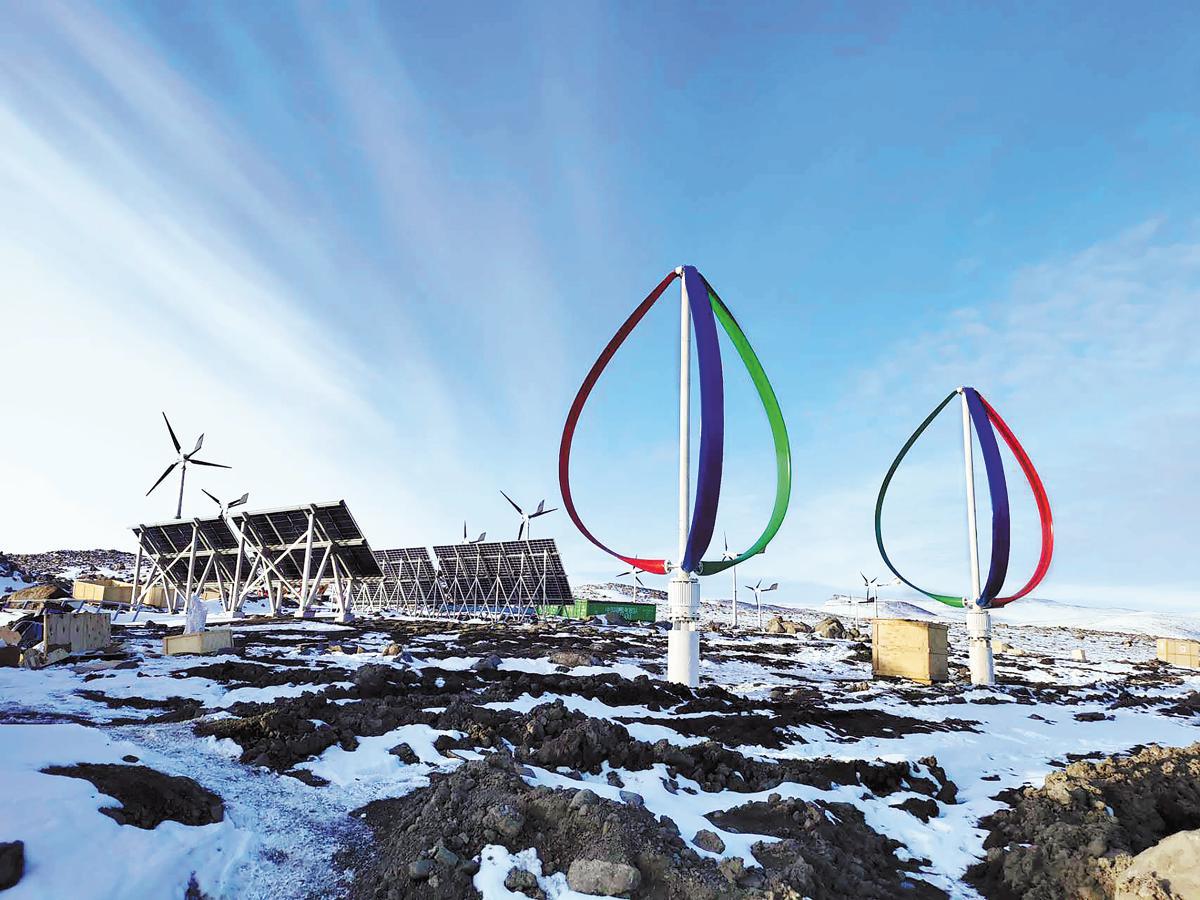
Two droplet-shaped wind turbines spin in front of China's Qinling station in Antarctica. [Photo/China Daily]
A clean energy system tailored for polar conditions has been put into operation in China's Qinling station in Antarctica.
The breakthrough means China has become the first country to achieve the large-scale operation of a clean energy system under extreme Antarctic conditions.
Lead scientist Sun Hongbin, 56, told China Daily that the project marks an achievement in China's green scientific exploration in the field of polar energy, and signifies that the nation's polar exploration has developed from the diesel era into a new era of green energy.
The system will generate a wealth of data, as well as present challenges that will prompt continuous research, said Sun, who is also the chief scientist on polar clean energy at the Polar Research Institute of China and president of Taiyuan University of Technology in Shanxi province.
Since the launch of the system on March 1, it has replaced traditional diesel power sources, providing uninterrupted zero-carbon power for the research equipment and essential living facilities at Qinling station, which was established in February last year as China's fifth Antarctic research station.
Photovoltaic and wind power account for 60 percent of the energy capacity of the system. In situations without wind or sunlight, stored hydrogen can provide power to the station, ensuring short-term operation for research equipment and basic living facilities.
Sun stressed the primary challenges in ensuring the reliability and safety of the equipment. For instance, the development of the droplet-shaped wind turbine capable of operating on ice caps and hydrogen fuel cells demands cold-resistant power-up technology.
Construction of the system at the station commenced in 2023.
As much of the equipment and facilities required specialized research and modification to adapt to the extreme conditions, Taiyuan University of Technology established a digital twin laboratory simulating the environment of Antarctica.
This laboratory possesses the capabilities to simulate nearly 10 extreme conditions, including extreme cold, strong winds, blizzards, polar day and night, intense geomagnetic fields, strong ultraviolet radiation, low pressure and low oxygen levels.
The primary purpose of establishing this laboratory was to address the challenges of research, testing and operation, Sun said.
"Once the equipment arrives in Antarctica, we have no means to procure a replacement if a single screw malfunctions," he said. "Before deployment to Antarctica, various new energy devices underwent testing here. Now the laboratory receives and analyzes real-time data transmitted back from Antarctica."
In recent years, various countries have explored approaches to develop clean energy in Antarctica, with solar and wind energy being the primary focus.
However, the extreme conditions and shortage of technologies make it tough for solar and wind power generation equipment to maintain stable and efficient operation.
China is the first country to implement hydrogen energy in the extreme environment of Antarctica on a large scale, said Dou Yinke, dean of the Taiyuan university's College of Electrical and Power Engineering, and a leading expert who has participated in multiple Antarctic expeditions since 2004.
Against the backdrop of global warming and glacier melting, China proposed the concept of "green exploration" in 2017, Dou said. International organizations have repeatedly urged countries to transition from fuel-based power generation to clean energy in Antarctica.
As Antarctica possesses vast wind and solar energy potential, countries worldwide have been exploring clean energy in this area.
To date, approximately 30 Antarctic research stations have installed clean energy generation devices, with over half utilizing solar or wind, Dou said.
However, due to the lack of systematic application and development of clean energy technologies tailored to the Antarctic environment, these systems cannot yet fully replace traditional energy systems on the aspects of safety and stability, he said.
Currently, 80 to 90 percent of the world's Antarctic research stations still rely on fuel-powered electricity generation, leading to significant environmental pollution in the polar regions, said Dou.
Last year, the Taiyuan university led the formulation of the "Twelve-Year Development Outline for Clean Energy Utilization Technologies in the Antarctic", aiming to establish a comprehensive clean energy supply system for Antarctic research stations by 2035.
"I will dedicate my whole life to the cause. I believe we have just taken the first step on a long journey. It is a demonstration and an experiment," Sun said. Key technology breakthroughs can also drive the energy revolution in the province, a major energy base in China, said Sun.
Sun hopes to establish a 20,000-square-meter Antarctic extreme environment simulation laboratory in Shanxi to enhance future research.
"With clean energy, people can survive in polar regions. In the future, we may even install and test this technology on the moon and Mars," Sun said.







 京公網(wǎng)安備 11010802027341號
京公網(wǎng)安備 11010802027341號 主站蜘蛛池模板:
阿v免费在线观看|
亚洲AV无码AV制服另类专区|
日本三级韩国三级美三级91|
成人精品一区二区户外勾搭野战|
亚洲欧美日韩久久精品第一区|
视频一区视频二区制服丝袜|
国产欧美视频在线|
wc女厕所散尿hd|
成人性一级视频在线观看|
亚洲免费在线观看|
精品国产丝袜自在线拍国|
国产欧美日韩专区|
69视频在线看|
在线看欧美三级中文经典
|
国产精品无码翘臀在线观看|
久久97久久97精品免视看|
欧美日韩在线观看视频|
人人爽人人爽人人片av|
芭蕉私人影院在线观看|
国产精品无码一本二本三本色|
一本一道精品欧美中文字幕|
最近中文字幕大全高清视频|
伊人热热久久原色播放www|
越南大胆女人体337p欣赏|
国产成人午夜精品影院游乐网|
99久久亚洲精品无码毛片|
成年人网站在线免费观看|
久久久久人妻一区精品性色av|
欧美日韩视频在线观看高清免费网站|
台湾佬中文222vvv娱乐网在线|
国产婷婷综合丁香亚洲欧洲|
在线观看中文字幕码|
japanese国产在线观看|
无码人妻精品一二三区免费|
亚洲国产欧洲综合997久久|
精品一区二区三区AV天堂|
国产亚洲精品资源在线26U|
老司机亚洲精品|
天天综合亚洲色在线精品|
中文字幕电影在线观看|
日韩精品免费视频|
主站蜘蛛池模板:
阿v免费在线观看|
亚洲AV无码AV制服另类专区|
日本三级韩国三级美三级91|
成人精品一区二区户外勾搭野战|
亚洲欧美日韩久久精品第一区|
视频一区视频二区制服丝袜|
国产欧美视频在线|
wc女厕所散尿hd|
成人性一级视频在线观看|
亚洲免费在线观看|
精品国产丝袜自在线拍国|
国产欧美日韩专区|
69视频在线看|
在线看欧美三级中文经典
|
国产精品无码翘臀在线观看|
久久97久久97精品免视看|
欧美日韩在线观看视频|
人人爽人人爽人人片av|
芭蕉私人影院在线观看|
国产精品无码一本二本三本色|
一本一道精品欧美中文字幕|
最近中文字幕大全高清视频|
伊人热热久久原色播放www|
越南大胆女人体337p欣赏|
国产成人午夜精品影院游乐网|
99久久亚洲精品无码毛片|
成年人网站在线免费观看|
久久久久人妻一区精品性色av|
欧美日韩视频在线观看高清免费网站|
台湾佬中文222vvv娱乐网在线|
国产婷婷综合丁香亚洲欧洲|
在线观看中文字幕码|
japanese国产在线观看|
无码人妻精品一二三区免费|
亚洲国产欧洲综合997久久|
精品一区二区三区AV天堂|
国产亚洲精品资源在线26U|
老司机亚洲精品|
天天综合亚洲色在线精品|
中文字幕电影在线观看|
日韩精品免费视频|